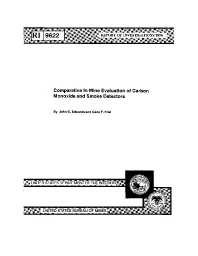Mining Publication: Comparative In-Mine Evaluation of Carbon Monoxide and Smoke Detectors
Original creation date: January 1996
A series of liquid fuel fire experiments evaluated the comparative responses of five types of commercially available smoke detectors and a diffusion-mode carbon monoxide (CO) detector under normal and reduced airflow conditions based upon the alarm times of the detectors. These experiments were conducted in the Safety Research Coal Mine at the U.S. Bureau of Mines Pittsburgh Research Center. Two of the smoke detectors had manufacturer set alarms. For the other three smoke detectors, an alarm point was defined in terms of their background analog signal and the detector's electrical output noise under ambient conditions. A correlation was developed of the travel time of 5 ppm CO between pairs of CO detectors with the travel time calculated from entry and crosscut volumes and measured airflow. Based upon the relative performance of smoke detectors in this limited study, smoke detectors can be as effective as CO detectors for mine fire detection once identifiable alarm values are defined. Implementation of smoke detectors as part of an atmospheric mine monitoring system will improve mine safety.
Authors: JC Edwards, GF Friel
Report of Investigations - January 1996
NIOSHTIC2 Number: 00233934
Pittsburgh, PA: U.S. Department of the Interior, Bureau of Mines, RI 9622, 1996 Jan; :1-7
See Also
- CO Dispersion from a Coal Fire in a Mine Entry
- A Comparison of Mine Fire Sensors
- Evaluation of Smoke and Gas Sensor Responses for Fires of Common Mine Combustibles
- Fire Detection for Conveyor Belt Entries
- In-Mine Evaluation of Smart Mine Fire Sensor
- In-Mine Evaluation of Smoke Detectors
- Multiple Type Discriminating Mine Fire Sensors
- Overview of Mine Fire Detection
- Real-time Neural Network Application to Mine Fire - Nuisance Emissions Discrimination
- Technology News 498 - Multiple Fire Sensors for Mine Fire Detection and Nuisance Discrimination
- Content source: National Institute for Occupational Safety and Health, Mining Program


 ShareCompartir
ShareCompartir
